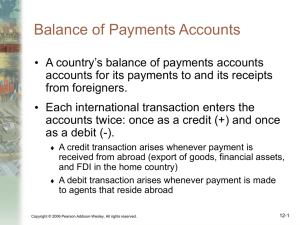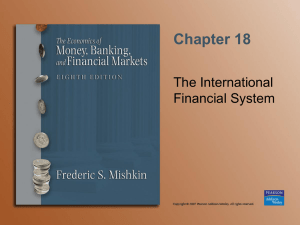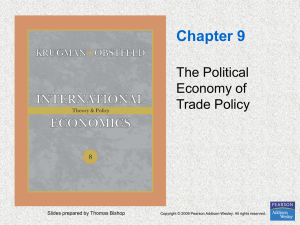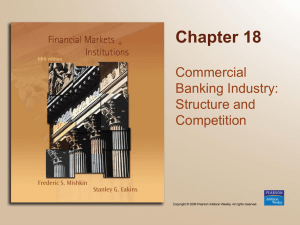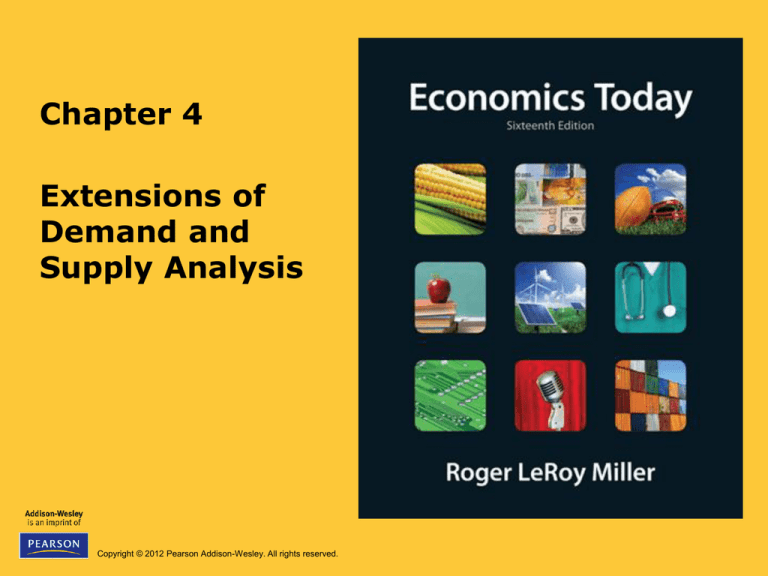
Chapter 4
Extensions of
Demand and
Supply Analysis
Copyright © 2012 Pearson Addison-Wesley. All rights reserved.
Introduction
The global demand for water doubles every 20 years,
so there will likely be pressure of its equilibrium price
to rise.
In fact, inflation-adjusted prices of water have
barely increased because government controls keep
water prices lower than they otherwise would be.
In this chapter, you will learn why such regulations
have contributed to shortages of water in some
nations.
Copyright © 2012 Pearson Addison-Wesley. All rights reserved.
4-2
Learning Objectives
• Discuss the essential features of the price
system
• Evaluate the effects of changes in demand
and supply on the market price and
equilibrium quantity
• Understand the rationing function of prices
Copyright © 2012 Pearson Addison-Wesley. All rights reserved.
4-3
Learning Objectives (cont'd)
• Explain the effects of price ceilings
• Explain the effects of price floors
• Describe various types of governmentimposed quantity restrictions on markets
Copyright © 2012 Pearson Addison-Wesley. All rights reserved.
4-4
Chapter Outline
•
•
•
•
•
•
•
•
The Price System and Markets
Changes in Demand and Supply
The Rationing Function of Prices
The Policy of Government-Imposed Price
Controls
The Policy of Controlling Rents
Price Floors in Agriculture
Price Floors in the Labor Market
Quantity Restrictions
Copyright © 2012 Pearson Addison-Wesley. All rights reserved.
4-5
Did You Know That ...
• Nearly 90,000 U.S. residents seek kidney
transplants each year, but only about 20,000
kidney transplants occur?
• Despite the high demand for kidney transplants,
selling a kidney is illegal, so the maximum price of
a kidney—called a price ceiling—is $0.
Copyright © 2012 Pearson Addison-Wesley. All rights reserved.
4-6
The Price System and Markets
• Price System or Market System
– An economic system in which relative prices
are constantly changing to reflect changes in
supply and demand
• The prices are signals as to what is relatively scarce
and relatively abundant
• Prices provide information to individuals and
businesses
Copyright © 2012 Pearson Addison-Wesley. All rights reserved.
4-7
The Price System and Markets
(cont'd)
• Voluntary Exchange
– An act of trading between individuals in the
price system
– Makes both parties to the trade subjectively
better off
Copyright © 2012 Pearson Addison-Wesley. All rights reserved.
4-8
The Price System and Markets
(cont'd)
• Transaction Costs
– All of the costs associated with exchange
– Including:
• The informational costs of finding out the price and
quality, service record, and durability of a product
• The cost of contracting and enforcing that contract
Copyright © 2012 Pearson Addison-Wesley. All rights reserved.
4-9
The Price System and Markets
(cont'd)
• The role of middlemen
– Middlemen (intermediaries) or brokers reduce
transaction costs by providing information to
buyers and sellers
– Examples
•
•
•
•
Real estate brokers
Stock brokers
Consignment shops
Car dealerships
Copyright © 2012 Pearson Addison-Wesley. All rights reserved.
4-10
International Example: Assisting Scattered
Emigrants Who Want to Help Kin at Home
• About 25 million people have left India to work in
other nations around the globe.
• To assist Indian emigrants who desire to help
family members back home, a company called
Sahara Care House offers a suite of 60 products
and services, including delivering flowers and
dropping off good and clothing to emigrants’
families in India.
• By performing tasks for family members on behalf
of Indian expatriates, this company acts as a
middleman.
Copyright © 2012 Pearson Addison-Wesley. All rights reserved.
4-11
Changes in Demand and Supply
• Changes in supply and demand create a
disequilibrium.
• The market price and quantity adjust to a
new equilibrium.
Copyright © 2012 Pearson Addison-Wesley. All rights reserved.
4-12
Figure 4-1 Shifts in Demand and in Supply:
Determinate Results, Panel (a)
Copyright © 2012 Pearson Addison-Wesley. All rights reserved.
4-13
Figure 4-1 Shifts in Demand and in Supply:
Determinate Results, Panel (b)
Copyright © 2012 Pearson Addison-Wesley. All rights reserved.
4-14
Figure 4-1 Shifts in Demand and in Supply:
Determinate Results, Panel (c)
Copyright © 2012 Pearson Addison-Wesley. All rights reserved.
4-15
Figure 4-1 Shifts in Demand and in Supply:
Determinate Results, Panel (d)
Copyright © 2012 Pearson Addison-Wesley. All rights reserved.
4-16
Changes in Demand and Supply
(cont'd)
• Summary
– Increases in demand increase equilibrium price
and quantity
– Decreases in demand decrease equilibrium
price and quantity
Copyright © 2012 Pearson Addison-Wesley. All rights reserved.
4-17
Changes in Demand and Supply
(cont'd)
• Summary
– Increases in supply decrease equilibrium price
and increase equilibrium quantity
– Decreases in supply increase equilibrium price
and decrease equilibrium quantity
Copyright © 2012 Pearson Addison-Wesley. All rights reserved.
4-18
Changes in Demand and Supply
(cont'd)
• When both demand and supply change
– If both the supply and demand curves shift
simultaneously, the outcome is indeterminate
for either equilibrium price or equilibrium
quantity
– The resulting effect depends upon how much
each curve shifts
Copyright © 2012 Pearson Addison-Wesley. All rights reserved.
4-19
Changes in Demand and Supply
(cont'd)
• When both demand & supply increase
– Change in equilibrium price is indeterminate
– Equilibrium quantity increases unambiguously
• When both demand & supply decrease
– Change in equilibrium price is indeterminate
– Equilibrium quantity decreases unambiguously
Copyright © 2012 Pearson Addison-Wesley. All rights reserved.
4-20
Changes in Demand and Supply
(cont'd)
• When supply decreases & demand
increases
– Equilibrium price increases
– The change in the equilibrium quantity is
uncertain without more information
• When supply increases & demand
decreases
– Equilibrium price decreases
– The change in the equilibrium quantity is
uncertain without more information
Copyright © 2012 Pearson Addison-Wesley. All rights reserved.
4-21
International Example: What Accounts for
Rising Pork Prices in China?
• Since the early 2000s, Chinese pork prices have
surged. Why?
• Pork is a normal good, so that rising Chinese
incomes had raised the demand for pork.
• Meanwhile, rising prices of feed for hogs and
higher prices of land to raise hogs contributed to
a reduction in the supply of pork.
Copyright © 2012 Pearson Addison-Wesley. All rights reserved.
4-22
Figure 4-2 The Effects of a Simultaneous
Decrease in Pork Supply and Increase in Pork
Demand
Copyright © 2012 Pearson Addison-Wesley. All rights reserved.
4-23
Changes in Demand and Supply
(cont'd)
Price Flexibility
• Prices quite flexible in some markets can
be less flexible in other market scenarios.
– May take the form of subtle adjustments such
as hidden payments, quality changes
– May not reach equilibrium right away
Copyright © 2012 Pearson Addison-Wesley. All rights reserved.
4-24
Changes in Demand and Supply
(cont'd)
• Adjustment speed
– Market characteristics influence adjustment
speed
– Markets may overshoot in the adjustment
process
– Markets are subject to energy shocks, labor
strikes, severe weather
Copyright © 2012 Pearson Addison-Wesley. All rights reserved.
4-25
The Rationing Function of Prices
• Synchronization of decisions of buyers and
sellers that leads to equilibrium is called
the rationing function of prices
Copyright © 2012 Pearson Addison-Wesley. All rights reserved.
4-26
The Rationing Function of Prices
(cont'd)
• Methods of non-price rationing
– Rationing by queues (waiting in line)
– Rationing by random assignment or coupons
Copyright © 2012 Pearson Addison-Wesley. All rights reserved.
4-27
The Rationing Function of Prices
(cont'd)
• The essential role of rationing
– Implied by the presence of scarcity
– Price vs. non-price rationing mechanism:
• Price rationing leads to the most efficient use of
available resources
• All gains from mutually beneficial trade are captured
in a freely rationing price system
Copyright © 2012 Pearson Addison-Wesley. All rights reserved.
4-28
The Policy of Government-Imposed
Price Controls
• Price Controls
– Government-mandated minimum or maximum
prices
• Price Ceiling
– A legal maximum price
• Price Floor
– A legal minimum price
Copyright © 2012 Pearson Addison-Wesley. All rights reserved.
4-29
The Policy of Government-Imposed
Price Controls (cont'd)
• Price ceiling and black markets
– A price ceiling may prevent the equilibrium
price from being achieved if it is above the
ceiling price
– A price ceiling that is set below the market
clearing price creates a shortage
Copyright © 2012 Pearson Addison-Wesley. All rights reserved.
4-30
The Policy of Government-Imposed
Price Controls (cont'd)
• Non-Price Rationing Devices
– All methods used to ration scarce goods that
are price-controlled
• Black Market
– A market in which price-controlled goods are
sold at an illegally high price
Copyright © 2012 Pearson Addison-Wesley. All rights reserved.
4-31
Figure 4-3 Black Markets for Portable
Electric Generators
Copyright © 2012 Pearson Addison-Wesley. All rights reserved.
4-32
International Example: The Rice Must Be White!
• In Venezuela, there is a legal ceiling price of white
rice of about 1 cent per kilogram, which is about
half of the price at which most Venezuelan rice
sellers are willing to offer white rice.
• What would you suppose that rice sellers in
Venezuela could do to avoid the effect of the
government’s price controls on white rice?
Copyright © 2012 Pearson Addison-Wesley. All rights reserved.
4-33
The Policy of Controlling Rents
•
The functions of rental prices
1. Promote the efficient maintenance and
construction of housing
2. Allocate existing housing
3. Ration the use of housing
Copyright © 2012 Pearson Addison-Wesley. All rights reserved.
4-34
The Policy of Controlling Rents
(cont'd)
• Rent controls and construction
– Controls discourage construction
• With a 16% vacancy rate and no controls, Dallas
recently built 11,000 new rental units
• With a 1.6% vacancy rate and controls, San Francisco
recently built 2,000 new rental units
Copyright © 2012 Pearson Addison-Wesley. All rights reserved.
4-35
The Policy of Controlling Rents
(cont'd)
• Effects on the existing supply of housing
and current use of housing
– Property owners cannot recover costs
• Maintenance, repairs, capital improvements
– Rations the current use of housing
• Reduces mobility, e.g., New York’s “housing gridlock”
Copyright © 2012 Pearson Addison-Wesley. All rights reserved.
4-36
The Policy of Controlling Rents
(cont'd)
• Attempts to evade rent controls
– Forcing tenants to leave
– Tenants subletting apartments
– Housing courts
Copyright © 2012 Pearson Addison-Wesley. All rights reserved.
4-37
The Policy of Controlling Rents
(cont'd)
• Who gains and who loses from rent
controls?
– Losers
• Property owners
• Low-income individuals
– Gainers
• Upper-income professionals
Copyright © 2012 Pearson Addison-Wesley. All rights reserved.
4-38
Why Not … require owners of residential buildings to
provide low-cost housing so that all U.S. residents can
“afford” roofs over their heads?
• The result of a legal price ceiling for residential
housing set lower than the market clearing price
would be a shortage of residential housing.
• More people would want to purchase or rent
housing at the ceiling price than owners of
residential housing would desire to supply.
Copyright © 2012 Pearson Addison-Wesley. All rights reserved.
4-39
Price Floors in Agriculture
• Support Price
– The government chooses a price floor for a
product and then acts to ensure that the price
of the product never falls below the support
level
• Associated with many agricultural products
• A price floor that is set above the market clearing
price results in a surplus.
Copyright © 2012 Pearson Addison-Wesley. All rights reserved.
4-40
Figure 4-4 Agricultural Price Supports
Copyright © 2012 Pearson Addison-Wesley. All rights reserved.
4-41
Price Floors in Agriculture (cont'd)
• Questions
– How could the government keep the price from
falling?
– Who benefits from agricultural price supports?
Copyright © 2012 Pearson Addison-Wesley. All rights reserved.
4-42
Price Floors in the Labor Market
• Minimum Wage
– A wage floor, legislated by government, setting
the lowest hourly wage rate that firms may
legally pay their workers
Copyright © 2012 Pearson Addison-Wesley. All rights reserved.
4-43
Figure 4-5 The Effect of Minimum
Wages
Copyright © 2012 Pearson Addison-Wesley. All rights reserved.
4-44
Policy Example: Bad Timing for Increasing the
Minimum Wage
• In 2007, Congress decided to increase the hourly
minimum wage in 3 steps from $5.15 to $7.25 in
2009.
• By 2008, the unemployment rate was 5.8
percent. When the final $0.70-per hour increase
was added in 2009, the U.S. economy was
experiencing an economic downturn with a 9.4
unemployment rate.
• If the imposition of a minimum wage currently
generates unemployment, what happens to the
unemployment rate when the demand for labor
declines?
Copyright © 2012 Pearson Addison-Wesley. All rights reserved.
4-45
Quantity Restrictions
• Governments can impose quantity
restrictions, most obvious—banning
ownership or trading of a good
– Human organs
– Drugs
– Hospital beds
– Gold from 1933 to 1973
Copyright © 2012 Pearson Addison-Wesley. All rights reserved.
4-46
Quantity Restrictions (cont'd)
• Government Prohibitions and Licensing
Requirements
– Some commodities cannot be purchased at all
legally; others require a license
• Import Quota
– Supply restriction that prohibits the importation
of more than a specified quantity of a particular
good
Copyright © 2012 Pearson Addison-Wesley. All rights reserved.
4-47
You Are There: “Cash for Clunkers” Subsidies
and the Market for “Liquid Glass”
• “Liquid glass” is a sodium-silicate chemical that
auto mechanics use for stopping leaks in engine
gaskets.
• In 2009, that chemical rose from less than $2.50
per quart to nearly $3.50 per quart.
• What effect did the federal government’s “Cash
for Clunkers” program, which offered subsidies for
people to trade in energy-inefficient vehicles,
have on the demand and the market clearing
price of liquid glass?
Copyright © 2012 Pearson Addison-Wesley. All rights reserved.
4-48
Issues & Applications: Contemplating Two Ways
to Tackle Water Shortages
• What can be done to help the roughly 20 percent
of the world’s human population who are unable
to obtain as much usable freshwater as they
desire?
• Ending government-mandated price ceilings on of
usable freshwater is one way to eliminate water
shortages.
• Another way to cut shortages is to remove salt
from seawater.
Copyright © 2012 Pearson Addison-Wesley. All rights reserved.
4-49
Figure 4-6 Two Methods of Eliminating a
Water Shortage, panel (a)
Copyright © 2012 Pearson Addison-Wesley. All rights reserved.
4-50
Figure 4-6 Two Methods of Eliminating a
Water Shortage, panel (b)
Copyright © 2012 Pearson Addison-Wesley. All rights reserved.
4-51
Summary Discussion of Learning
Objectives
• Essential features of the price system
– A price system (market system) allows prices
to respond to changes in supply and demand
for different commodities
– Prices are communicated in markets that tend
to minimize transactions costs
Copyright © 2012 Pearson Addison-Wesley. All rights reserved.
4-52
Summary Discussion of Learning
Objectives (cont'd)
• How changes in demand and supply affect
market price and equilibrium quantity
– Increases in demand increase equilibrium price
and quantity; decreases in demand decrease
equilibrium price and quantity
– Increases in supply decrease market price and
increase equilibrium quantity; decreases in
supply increase market price and decrease
equilibrium quantity
Copyright © 2012 Pearson Addison-Wesley. All rights reserved.
4-53
Summary Discussion of Learning
Objectives (cont'd)
• How changes in demand and supply affect
equilibrium price and equilibrium quantity
– When both demand and supply shift at the
same time, the outcome is indeterminate for
either equilibrium price or equilibrium quantity
Copyright © 2012 Pearson Addison-Wesley. All rights reserved.
4-54
Summary Discussion of Learning
Objectives (cont'd)
• The rationing function of prices
– In a market system, prices ration scarce goods
and services
– Other ways of rationing include first come, first
served; political power; physical force; random
assignment; and coupons
Copyright © 2012 Pearson Addison-Wesley. All rights reserved.
4-55
Summary Discussion of Learning
Objectives (cont'd)
• The effects of price ceilings
– A price ceiling set below the market clearing
price results in a shortage
• The resulting shortage can lead to non-price rationing
devices and black markets
Copyright © 2012 Pearson Addison-Wesley. All rights reserved.
4-56
Summary Discussion of Learning
Objectives (cont'd)
• The effects of price floors
– If the price floor is set above the market
clearing price, a surplus results
• A price floor can take the form of a governmentimposed price support or minimum wage
Copyright © 2012 Pearson Addison-Wesley. All rights reserved.
4-57
Summary Discussion of Learning
Objectives (cont'd)
• Government-imposed restrictions on
market quantities
– Bans on sale or ownership
– Licensing restrictions
– Import quotas
Copyright © 2012 Pearson Addison-Wesley. All rights reserved.
4-58
Appendix B: Consumer Surplus
• Consumer Surplus
– The difference between the total amount that
consumers would have been willing to pay for
an item and the total amount that they actually
pay
Copyright © 2012 Pearson Addison-Wesley. All rights reserved.
4-59
Figure B-1 Consumer Surplus
Copyright © 2012 Pearson Addison-Wesley. All rights reserved.
4-60
Appendix B: Producer Surplus
• Producer Surplus
– The difference between the total amount that
producers actually receive for an item and the
total amount that they would have been willing
to accept for supplying that item
Copyright © 2012 Pearson Addison-Wesley. All rights reserved.
4-61
Figure B-2 Producer Surplus
Copyright © 2012 Pearson Addison-Wesley. All rights reserved.
4-62
Appendix B: Gains from Trade within a Price
System
• Gains from trade
– The sum of consumer surplus and producer
surplus
Copyright © 2012 Pearson Addison-Wesley. All rights reserved.
4-63
Figure B-3 Consumer Surplus, Producer
Surplus, and Gains from Trade
Copyright © 2012 Pearson Addison-Wesley. All rights reserved.
4-64
Appendix B: Price Controls and Gains
from Trade
• How do price controls affect gains from
trade?
– Consumer surplus and producer surplus are
both lower
– Either a price ceiling or a price floor reduces
gains from trade
Copyright © 2012 Pearson Addison-Wesley. All rights reserved.
4-65



